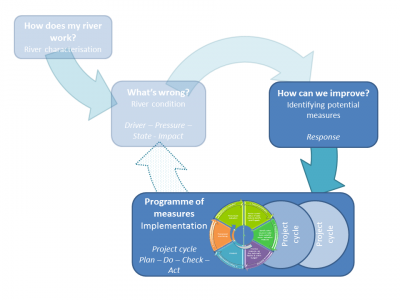How can we improve?
An integrated planning framework supports the design of river restoration measures. This framework is cyclic for both entire river basins (catchments) and individual projects.
The planning frameworks are presented below. Relevant definitions for restoration planning are given here. Further reading: benchmarking and setting end-points <hyperlink to D5.1>, cost-effectiveness and benefits <hyperlink to D5.2>, climate and land-use changes <hyperlink to D5.3>, risks and uncertainty <hyperlink to D5.4>.
@Erik, should the hyperlinks be directed to PDFs of reform website or to wiki-pages with this content (like Restoration_planning)
Contents
Planning at a catchment scale
Restoration planning at a catchment scale has six main steps:
- River characterization
- River condition. The DPSIR framework captures the key relationships between society and the environment across multiple sectors. Conflict and resolution matrices support effective collaboration between disciplines and interaction with policy makers and local stakeholders.
- River restoration potential. This regards the level of ecological improvement that can be achieved, considering the influence of sector activities (drivers) and whether rivers are classified as “heavily modified water body” or “artificial”. The DPSIR framework <hyperlink to planning tool “DPSIR: Driver – Pressures – State – Impact – Response”> helps in identifying multi-benefits by linking the ecosystem approach, ecosystem services and societal benefits that come from these services. The effects on biota are higher in gravel-bed mountain rivers with low land-use pressure <hyperlink to separate window with key message #9: Slightly higher effects in gravel-bed mountain rivers with low land-use pressure>.
- Programme of measures. The measures necessary to meet the environmental objectives of the WFD cost-effectively are developed in association with the responsible authorities and other stakeholders. They include hydromorphological measures <hyperlink to “Measures” in the wiki>. There is no single “best measure”, but widening generally has a high effect <hyperlink to separate window with key message #6: There is no single “best measure” but widening generally has a high effect>. Restoring specific habitats is more important than merely increasing habitat diversity <hyperlink to separate window with key message #7: It is important to restore specific habitats, not necessarily mere habitat diversity>.
- Project identification. Clear objectives need to be set to justify the rehabilitation measures selected. The identification of projects is supported by a decision matrix <hyperlink to planning tool “Decision matrix”>. Small restoration projects do work, but larger projects with a long-term plan are recommended <hyperlink to separate window with key message #8: Small restoration projects work, but better act big and long-term>.
- The project cycle for the planning of individual projects.
Planning of individual projects
The planning of individual river restoration projects sets project objectives to improve ecological status at a local scale whilst keeping the project in a river basin or catchment context. The project cycle in the figure follows the basic PDCA (Plan, Do, Check, Act) structure, but includes more detailed planning phases in the first part. Having identified the project within planning at the catchment scale, the following five phases play a key role:
- Project formulation
- Financing
- Project implementation
- Post-project monitoring
- Post-project evaluation
Project formulation
The attention for project formulation focuses on the acceptability of the project and the desired outcomes. The DPSIR framework <hyperlink to planning tool “DPSIR: Driver – Pressures – State – Impact – Response”> allows identification of appropriate rehabilitation measures. The setting of achievable goals and objectives is supported by defining benchmarks and endpoints <hyperlink to planning tool “Benchmarks and endpoints”>, formulating SMART project objectives <hyperlink to planning tool “Setting SMART project objectives”>, problem tree analysis <hyperlink to planning tool “Problem tree analysis and tree of objectives”>, logical framework approach <hyperlink to planning tool “Logical framework approach”>, risk and uncertainty analysis <hyperlink to FUTURE planning tool “Risk and uncertainty analysis”>, and multiple-criteria decision analysis <hyperlink to FUTURE planning tool “Multiple-criteria decision analysis”>. Monitoring <hyperlink to planning tool “Monitoring design”> is designed to evaluate overall project effectiveness by comparing results with the objectives. Terrestrial and semi-aquatic species benefit most from restoration <hyperlink to separate window with key message #3: Terrestrial and semi-aquatic species benefit most from restoration>. The result is a higher number of individuals rather than new species <hyperlink to separate window with key message #4: Restoration results in a higher number of individuals but few new species>. Specific traits or species are affected rather than the mere number of total species <hyperlink to separate window with key message #5: Restoration affects specific species or traits rather than the mere total number of species>.
Financing
The planning of financing is supported by cost-benefit analysis <hyperlink to FUTURE planning tool “Cost-benefit analysis”> and cost-effectiveness analysis <hyperlink to FUTURE planning tool “Cost-effectiveness analysis”>. Restoration pays, because it increases ecosystem services <hyperlink to separate window with key message #2: Restoration pays – it increases ecosystem services>.
Project implementation
......
Post-project monitoring
Monitoring <hyperlink to planning tool “Monitoring design”> is essential for evaluating overall project effectiveness. Monitoring and adjustment go hand in hand, because nobody can fully predict restoration outcomes beforehand <hyperlink to separate window with key message #1: Monitor and adjust your project – nobody can fully predict restoration outcomes >.
Post-project evaluation
The post-project evaluation phase assesses the overall project effects and the sectoral impact of the project on the basis of measurable indicators or endpoints in a logical framework <hyperlink to planning tool “Logical framework approach” >.
p.m.
